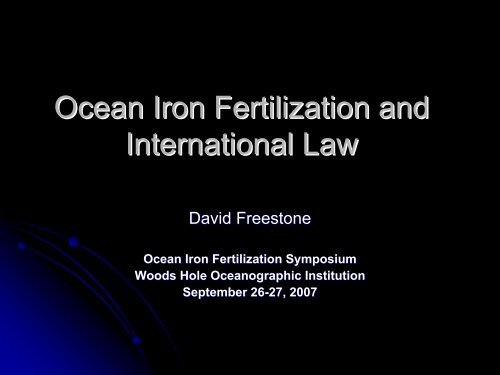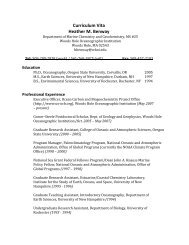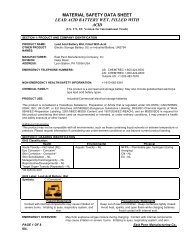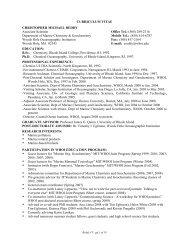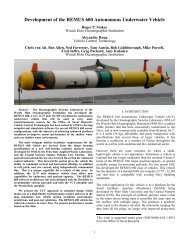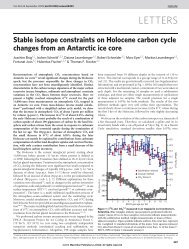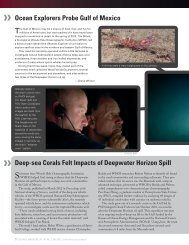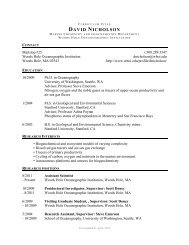View Powerpoint Presentation (pdf) - Woods Hole Oceanographic ...
View Powerpoint Presentation (pdf) - Woods Hole Oceanographic ...
View Powerpoint Presentation (pdf) - Woods Hole Oceanographic ...
You also want an ePaper? Increase the reach of your titles
YUMPU automatically turns print PDFs into web optimized ePapers that Google loves.
Today’s s <strong>Presentation</strong>• General Introduction – role of International Law• Brief examination of applicable regimes• Law of the Sea Convention• Regional regimes• Convention on the Conservation of Antarctic Marine LivingResources – CCMALR• Madrid Protocol to Antarctic Treaty• Regional Seas Conventions• London [Dumping] Convention and 1996 Protocol• General customary International Law• UNFCCC and Kyoto Protocol• Key International Legal Issues with ocean iron fertilisation:• Is it Pollution ?• Is it Dumping ?• Whose responsibility is this under Int. Law?• Position under the UNFCCC and the Kyoto Protocol
Role of International Law• Decentralized system• Relies on compliance and enforcement bystates• Either bilaterally or• through multilateral organs where applicable or• through International institutions• State have jurisdiction over activities• of their nationals• natural or legal• Within their territory
1982 Law of the Sea ConventionDefines maritime zones• Internal Waters – behind coastal baseline• Territorial Sea• up to 12 nm from coastal baseline• sovereignty of coastal states• Exclusive Economic Zone• Up to 200 nm from coastal baseline• Sovereign rights over resources• High Seas areas beyond nationaljurisdiction
1982 Law of the Sea Convention• LOSC largely represents customaryinternational law (US still not a party)• Prohibits states from polluting marineenvironment – including by dumping• Requires states cooperate to preventpollution and to• Legislate to prevent it• take enforcement action to prevent it
Regional regimes of importanceThree regions of particular interest:• Eastern Equatorial Pacific• South Pacific and SE Pacific regional seas• Sub arctic Pacific• Parts of the Southern Ocean• Covered by provisions of:• Convention on the Conservation of Antarctic Marine LivingResources – CCMALR• Madrid Protocol to Antarctic Treaty• Require prior environment impact assessment
1972 London [Dumping]Convention and its 1996 Protocol• Parties agree to “promote promote the effectivecontrol of all sources of pollution of themarine environment”• Regulates disposal of land-based wastes atsea• 1996 Protocol now incorporates aprecautionary approach• anything not listed in Annex 1 cannot be dumpedat sea• 2006 Amendment to Protocol permits storageof CO2 under the seabed.
1972 Convention: Article 1• Contracting States shall individually andcollectively promote the effective control ofall sources of pollution of the marineenvironment and• pledge themselves especially to take allpractical steps to prevent the pollution ofthe sea by the dumping of wastes andother matter….
1996 Protocol• Contracting Parties shall individually andcollectively protect and preserve themarine environment from all sources ofpollution and• take effective measures, according to theirscientific, technical and economiccapabilities, to prevent, reduce and wherepracticable eliminate pollution caused bydumping or incineration at sea of wastesor other matter.
Customary International LawStates shall:• Fulfil in good faith [their] obligations undergeneral principles and rules ofinternational Law• Not allow activities under national controlto damage territory of other states or areasbeyond national jurisdiction• Use a Precautionary Approach• Prior assessment ?
Precautionary Principle• 1992 Rio Declaration: Principle 15• “In order to protect the environment, theprecautionary approach shall be widelyapplied by states according to theircapabilities. Where there are threats ofserious or irreversible damage, lack of fullscientific certainty shall not be used as areason for postponing cost effective measureto prevent environmental degradation”
1992 UN Framework Conventionon Climate ChangeGeneral obligations• address stabilization of climate by sources anduse of sinks (art 4.1.d)• “should take precautionary measures ... lack ofscientific certainty should not be used as areason for postponing such measures ... which[should] ... cover all relevant sources, sinks andreservoirs of GHGs......” (art 3.2)• “...use appropriate methods, e.g. impactassessments..., with a view to minimisingadverse effects on... the quality of theenvironment”(art 4.1.f)
UNFCCC/Kyoto ProtocolCONTEXTUN Framework Convention on Climate ChangeKyoto ProtocolDomesticPolicy ActionsNon Annex ICountriesAnnex ICountriesEmissions TradingJoint ImplementationBinding Emission TargetsCDM
Kyoto Protocol 1997• Developed Countries (Annex I of UNFCCC)agreed GHG emissions reductions from 1990levels by an average of 5.2%• Commitment period is 2008-20122012• Specific targets (or assigned amounts) were setout in Annex B of the Protocol,• Iceland 10%+• Australia 8%+• European Union 8% reduction• Japan 7%• US 6%
Kyoto Protocol Targets• Annex I Countries have obligations tomeet Kyoto Protocol Targets• By two means:• “Domestic Policies and Measures”• Flexibility Mechanisms as “supplementarymeans”
Kyoto Protocol has three“Flexible Mechanisms”• Clean Development Mechanism –•Developed (Annex I) countries financeemission reductions in developing countries(non- Annex I).• Joint Implementation•Between Between (Annex I) developed countries• Carbon Trading•Between Between (Annex I) developed countries
1997 Kyoto Protocol’sClean Development Mechanism• Designed to assist:• “Non-Annex I Parties achieve sustainabledevelopment and• Annex I Parties achieve compliance with theircommitments• Protocol envisages a supervisory structure andcertification system.• CDM Executive Board approves projectdesigns and projects• Advice of methodology Panel (Meth(Panel)• certified by “operational entities” designatedby the Parties at the CoP/MoP.• Results are Certified Emission Reductions
Conditions for Participation in CDM• Must be voluntary;• Between Parties to Kyoto• projects must manifest real measurable andlong-term benefits relating to mitigation ofclimate change; and a• project activity must be “additional” to that whichwould have occurred in its absence.• Participation in the CDM is also open to theinvolvement of private and/or public entities,subject to the guidance of the Executive Board.• “sink projects in principle eligible” – pendingdecisions of CoP/MoP
State and Trends of the Carbon Market -2007Volumes transacted in 2006(World Bank)Project-BasedTransactions(in MtCO 2 e)Allowance MarketsCDM450JI16SecondaryCDM25 +EU EmissionTrading Scheme1,100Voluntary& Retail10 +OtherCompliance19New South WalesCertificates20Chicago ClimateExchange10 MtCO 2 eUK ETSna
Key Legal Issues• Key International Legal Issues to bedetermined in relation to OIF• Can OIF be regarded as pollution ?• Can it be regarded as dumping ?• Are OIF projects eligible for certificationunder the Kyoto Protocol
1982 Law of the Sea ConventionArt 1 (1)(4)• ‘Pollution of the marine environment’ means theintroduction by man, directly or indirectly, ofsubstances or energy into the marineenvironment … which results or is likely toresult in such deleterious effects as harm toliving resources and marine life, , hazards tohuman health, hindrance to marine activities,including fishing and other legitimate uses of thesea, impairment of quality for use of seawaterand reduction of amenities;• General Obligations• “to protect and preserve the marineenvironment” (art 192)• Take all measures “consistent with thisConvention to prevent, reduce and controlpollution” from all sources
Dumping 1982 Law of the SeaConvention• Article 1(1)(5) ‘dumping’ means• Any deliberate disposal of wastes or othermatter from vessels, aircraft, platforms orother man made structures at sea;• Article (1)(5) (b) ‘dumping’ does not include:• (ii) placement of matters for a purpose otherthan the mere disposal thereof, provided thatsuch placement is not contrary to thepurposes of this Convention• BUT : is this Dumping of Carbon ?• From vessels etc
1972 London Convention• Art 1 ‘dumping’ does not include• Placement of matter for a purpose other themere disposal thereof, provided that suchplacement is not contrary to the aims of theConvention• 1996 Protocol• One of the most important innovations is tointroduce (in Article 3) what is known as the"precautionary approach". This requires that"appropriate preventative measures are takenwhen there is reason to believe that wastes orother matter introduced into the marineenvironment are likely to cause harm even whenthere is no conclusive evidence to prove acausal relation between inputs and their effects.
1996 London Protocol• In implementing this Protocol, ContractingParties shall apply a precautionary approach toenvironmental protection from dumping ofwastes or other matter whereby appropriatepreventative measures are taken when there isreason to believe that wastes or other matterintroduced into the marine environment are likelyto cause harm even when there is no conclusiveevidence to prove a causal relation betweeninputs and their effects.
Can OIF projects be broughtwithin the Kyoto regime• Kyoto is a state to state System:• Must be clear state ownership,• Must be a host country,• Must be an acquiring country.• No category under CDM or JI under which theprojects could be classified• No general accounting for GHG stored in Oceans, itwill be difficult to create such category as it fallsoutside the IPCC reporting guidelines• Permanence and project specificity is a problem.• Project boundaries: can periodic monitoring andverification be ensured ?
Conclusions• If an activity is likely to “result in such deleteriouseffects as harm to living resources and marinelife” then it is “pollution”• States have an obligation to prevent, reduce andcontrol pollution• Deliberate dispersal of iron is probably notdumping (ie(not disposal) but may come withinthe general mandate of the London Conventionand its 1996 Protocol
Conclusions 2• OIF may in principle be justifiable by States – orunder their direct authority - under generalobligations of UNFCCC• but there is an obligation to use “appropriatemethods:” (ieimpact assessment) to minimizeadverse effects• OIF does not meet the current criteria for projectregistration under Kyoto Protocol• Responsibility of national governments to policethe informal private market for emission credits


